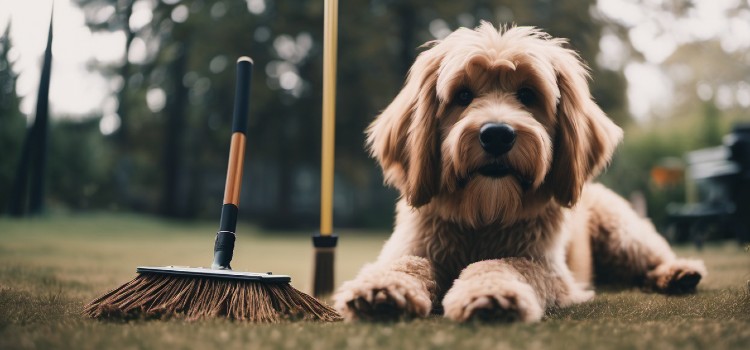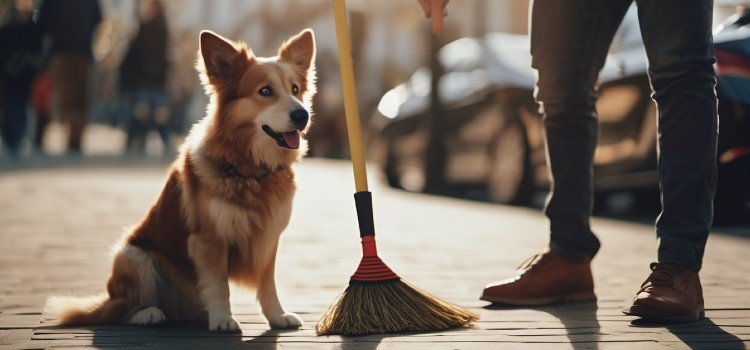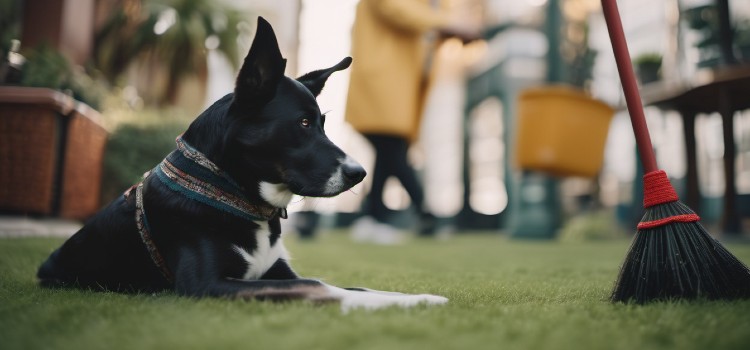As an Amazon Associate committed to the mission of improving the lives of our readers, Live-Clear.com receives a small commission from eligible purchases made through our affiliate links. This revenue enables us to keep producing insightful articles and other material.
Dogs are scared of brooms because the sound and movement can be unsettling and frightening to them. This fear may also be related to past negative experiences or environmental factors.
Understanding this fear can help pet owners find ways to help their dogs feel more comfortable and safe around brooms. Many dogs display fear or anxiety around brooms, and this behavior can be perplexing to their owners. This common fear can lead to challenges in maintaining a clean living environment or can create difficulties during grooming and cleaning routines.

By delving into the reasons behind this fear, pet owners can implement techniques and strategies to help their dogs overcome their apprehension and feel more at ease. This article explores the various reasons dogs may fear brooms and offers practical tips to help alleviate this fear.
Understanding Canine Phobias
Many dog owners have experienced their furry friends’ fear of brooms. This behavior might seem perplexing initially, but understanding the reasons behind it can help alleviate the anxiety of our canine companions. Canine phobias, including a fear of brooms, can significantly impact the behavior of dogs, which necessitates a deeper exploration of the underlying causes.
Impact Of Fear On Dogs’ Behavior
Fear plays a substantial role in shaping dogs’ behavior. When dogs experience fear, it can lead to various behavioral responses, such as trembling, barking, hiding, or even aggression. Pet owners must recognize and understand their dog’s fears to prevent unnecessary stress and anxiety. Additionally, by addressing these fears, it’s possible to improve our canine companions’ overall well-being and happiness.
Recognizing The Fear Triggers
Understanding why dogs are scared of brooms requires recognizing the fear triggers that affect them. By pinpointing these triggers, dog owners can better address their pet’s anxieties and work toward finding suitable solutions.
Noise And Movement Sensitivity
Dogs have heightened sensitivity to noise and movement, which can lead to fear when introduced to a broom’s foreign sounds and sweeping motions. The bristles may create a swishing sound as they move against the floor or carpet, while the rapid, comprehensive action can cause abrupt movements that unsettle the dog.
Gesture And Body Language Interpretation
Our canine companions are adept at interpreting gestures and body language. When using a broom, humans may inadvertently exhibit threatening or dominant body language, such as towering over the dog, making direct eye contact, or using forceful sweeping motions. Dogs may perceive these actions as signs of aggression, causing fear and avoidance.
Evolutionary Instincts In Dogs Scared of Brooms
Dogs have instinctual behaviors that have developed over thousands of years of evolution. These instincts have helped them survive and thrive in various environments. One of the fascinating aspects of a dog’s behavior is their fear of brooms. Let’s delve into the evolutionary reasons behind this intriguing behavior.
Role Of Survival Instincts
As descendants of wolves, dogs have inherited survival instincts that protect them from potential threats. The sight of a broom, with its long handle and bristles, triggers a natural defensive response in dogs. This response can be traced back to their ancestors’ experiences in the wild, where long, slender objects could resemble threats, such as snakes or predators.
The Influence Of Pack Mentality
Another evolutionary aspect contributing to a dog’s fear of brooms is their pack mentality. In the wild, wolves and their descendants relied on their pack for safety and survival. Any unfamiliar or potentially threatening object, like a broom, would prompt an instinctual reaction to protect themselves and their pack members.

Associations With Negative Experiences
Impact Of Past Traumas On Fear
Dogs’ fear of brooms can often stem from past negative experiences. If a dog has encountered punishment or physical harm with a broom, they may develop a strong aversion to it. Similarly, suppose they have experienced a loud and threatening gesture associated with a broom, such as its sudden movement or bristles against the floor. In that case, they can develop a deep-seated fear.
Another factor contributing to a dog’s fear of brooms is the association with unhappy or alarming events. For example, if the dog has witnessed someone displaying anger or aggression using a broom, they may associate brooms with negative energy and respond with fear and anxiety. Moreover, if the dog has experienced an accidental collision or injury caused by a broom, they may perceive it as a threat.
Behavioral Conditioning In Dogs Scared of Brooms
Behavioral conditioning in dogs plays a significant role in understanding their fear of brooms. Dogs can develop a fear of brooms through a process known as classical conditioning, where they associate the broom with negative experiences. This can lead to fear and anxiety towards brooms, making it essential for dog owners to understand the behavioral aspects of this fear.
Effects Of Repetitive Actions On Dogs Scared Of Brooms
Repetitive actions involving brooms can reinforce a dog’s fear, contributing to their apprehension towards them. Each time a dog encounters a broom in a negative context, such as scolding or punishment, it strengthens their fear response. This repetitive association can lead to a lasting fear of brooms, impacting the dog’s behavior and well-being.
Identifying Broom As A Menace
Dogs being scared of brooms is a typical yet intriguing behavior in many household pets. Understanding why dogs view the broom as a threat is crucial in addressing the issue. This article will delve into the visual and auditory stimuli that trigger this fear, shedding light on the reasons behind dogs’ aversion to brooms.
Analyzing The Visual And Auditory Stimuli Of Dogs Scared Of Brooms
Visual Stimuli: The threatening appearance of a broom can evoke fear in dogs due to its long, handle-like structure and the movements associated with sweeping. The swift, sweeping motions of the broom may resemble predatory behavior to dogs, causing distress and triggering their flight response.
Auditory Stimuli: The sound produced by a broom against hard surfaces could startle dogs, leading them to associate the broom with loud, unfamiliar noises, further exacerbating their fear. Dogs’ acute hearing makes them more sensitive to these sounds, contributing to their apprehension towards brooms.
Understanding the factors that contribute to dogs’ fear of brooms can aid in developing strategies to help them overcome their anxiety and live harmoniously in a broom-utilizing environment.

Communication Signals In Dogs Scared of Brooms
Understanding Canine Body Language
Dogs communicate through various body signals, and understanding these signals can provide insight into why they may be scared of particular objects, such as brooms. One essential aspect of canine communication is body language, which encompasses facial expressions, posture, tail position, and vocalizations. By recognizing these signals, owners can interpret their dog’s emotions and address fears or anxieties.
Common Body Language Signals Indicating Fear Or Anxiety
- Tail tucking: When feeling scared or threatened, a dog may tuck its tail between its legs.
- Yawning or lip licking: These subtle signs can indicate stress or discomfort in a dog.
- Ears pinned back: When a dog’s ears are pressed flat against its head, it may indicate anxiety or fear.
- Whale eye: When a dog shows the whites of its eyes, known as “whale eye,” it can indicate unease or tension.
- Raised hackles: The hair along a dog’s back and neck may stand up when feeling fearful or threatened.
Interpreting Fear Of Dogs Scared Of Brooms
Regarding dogs being scared of brooms, these communication signals can shed light on their behavior. A dog’s fear of brooms may stem from past negative experiences, perceived threats, or a general sensitivity to unfamiliar or imposing objects. By recognizing these signals and the specific triggers for their fear, owners can take steps to help their dogs overcome their apprehensions and feel more at ease in their environment.
Positive Reinforcement Techniques Of Dogs Scared Of Brooms
Strategies To Ease Fear Of Brooms
Dogs being scared of brooms is an expected behavior issue many pet owners encounter. Various positive reinforcement techniques can help alleviate a dog’s fear of brooms and other similar objects. Using positive reinforcement, pet owners can effectively change their dog’s fearful associations with brooms into positive ones.
Desensitization Training
Desensitization training involves gradually exposing the dog to the feared object in a controlled and positive way. This can be achieved through the following steps:
- Introduce the broom at a distance where the dog shows no signs of fear.
- Reward the dog with treats and praise for remaining calm in the presence of the broom.
- Gradually decrease the distance between the dog and the broom while providing positive reinforcement.
Counter Conditioning
Counterconditioning aims to change the dog’s adverse reactions to the broom into positive responses. This involves:
- Pairing the sight of the broom with something the dog loves, such as treats or playtime.
- Gradually associating the broom with positive experiences to help the dog overcome its fear.
Behavioral Modification
Implementing behavioral modification techniques can help dogs overcome their fear of brooms by addressing the underlying emotions and reactions. This may involve:
- Using calming signals and body language to reassure the dog when in the presence of the broom.
- Creating a positive association with the broom through fun activities and rewards.
- Seeking the guidance of a professional dog trainer or behaviorist if the fear is profoundly ingrained or causing significant distress.

Conclusion
Understanding why dogs fear brooms can help us address their fear and provide the support they need. By recognizing their instincts and using positive reinforcement, we can help them overcome their fear. Creating a safe and reassuring environment can ensure our furry friends feel secure and happy in our homes. In addition, seeking professional help from a dog trainer or behaviorist can also be beneficial in addressing and managing their fear of brooms. These experts can provide specialized techniques and guidance to desensitize dogs to brooms and build their confidence gradually. Ultimately, by taking these steps, we can help our dogs feel more comfortable and reduce their fear of brooms, leading to a happier and healthier relationship between us and our furry companions.
Frequently Asked Questions Of Why Are Dogs Scared Of Brooms
Dogs may fear sweepers due to their noise and sudden movements. This can trigger their natural fight-or-flight response. Additionally, dogs have sensitive hearing, and the loud sound of the sweeper can be distressing.
Dogs can be afraid of mops due to their size and unfamiliar appearance. The noise and movement can also startle them. Gradually introduce the mop to your dog with positive associations to help alleviate their fear.
Most dogs fear loud noises, thunderstorms, new environments, separation, and particular objects or situations. Dogs may also experience fear due to a lack of socialization or past traumatic experiences. Providing a safe and secure environment can help alleviate their concerns.
To desensitize your dog to a broom, start by placing the broom in the room. Reward calm behavior near the broom using treats. Gradually introduce movement and noise. Keep sessions short and positive, gradually increasing exposure over time. Consistency and patience are essential for success.
Dogs may fear brooms due to their unfamiliar appearance and sudden movements. It can trigger their instinct to be cautious.
Understanding why dogs fear brooms can help us address their fear and provide support. Recognizing instincts and using positive reinforcement can help dogs overcome their fear. Creating a safe environment can make them feel secure and happy. Seeking professional help from a dog trainer or behaviorist can help desensitize dogs to brooms and build their confidence. By doing so, we can help dogs feel more comfortable and reduce their fear, leading to a happier and healthier relationship with our furry companions.
Amazon and the Amazon logo are trademarks of Amazon.com, Inc, or its affiliates.



